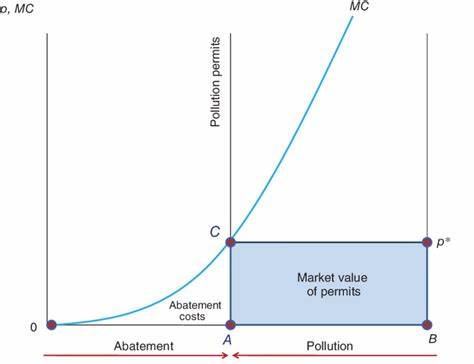Abatement costs refer to the expenses incurred in reducing or preventing environmental pollution or damage (for example from air emissions or waste disposal). It can be further identified as the total opportunity cost that is incurred by a producer, emitting any emissions, for reducing the emissions from the environment. With growing concerns over climate change and its impact on our planet, businesses are facing increasing pressure to address their carbon footprint and reduce their emissions. For instance, these are generally incurred as an endeavour to reduce, mitigate or reduce pollution, after a new regulation for the same has been passed. The assumption behind these assumptions is the presence of the public’s willingness to pay for the damage alleviated, which in turn, acts as the estimate of the damage, in consideration of the direct valuation of the costs. The costs associated with implementing measures to reduce these emissions can be significant, often requiring substantial investments in new technologies, equipment, and processes.
Categories of Abatement Cost
Abatement cost is categorised in four ways, namely, (1) the cost incurred during the production phase, for capturing and removing pollution soon after its production an example can be a car filter for air pollution; (2) recycling costs incurred in the processing of the water once it is produced so that it can be put to an alternative use; (3) disposal cost incurred for disposing of the waste generated upon production; and (4) prevention costs incurred for devising any process, technique or method that decreases the amount of pollution and/ or waste as generated in the production.
Direct and Indirect Cost Associated with Abatement
In addition to direct costs associated with reducing emissions, there are also indirect costs to consider. For example, businesses may be required to pay carbon taxes or invest in carbon offset schemes to compensate for the emissions they produce. Failure to comply with environmental regulations can also result in costly fines and legal action. While the upfront costs of implementing environmental measures can be high, businesses also stand to benefit from long-term cost savings. By investing in renewable energy sources or energy-efficient technologies, companies can reduce their overall energy consumption and lower their utility bills. Additionally, businesses that demonstrate a commitment to sustainability and responsible environmental practices may enjoy greater brand recognition and customer loyalty. In summary, while the costs associated with abating environmental damage can be substantial, the long-term benefits of investing in sustainable practices can more than outweigh these initial expenses. Abatement costs are looked upon very negatively on the earnings and reputation and image of the company, in the wake of demand for green business practices by various stakeholders.
Example of Abatement Cost
An example of abatement cost can be a charge of $2 billion on General Electric (GE) by the consent decree with the Environmental Protection Agency (EPA) for cleaning up 40 miles of the upper part of the Hudson River in New York, for producing and decomposing polychlorinated biphenyls between 1947 and 1977. By taking steps to reduce their carbon footprint, businesses can help protect the planet for future generations while also potentially reducing costs and gaining a competitive advantage in the marketplace.

